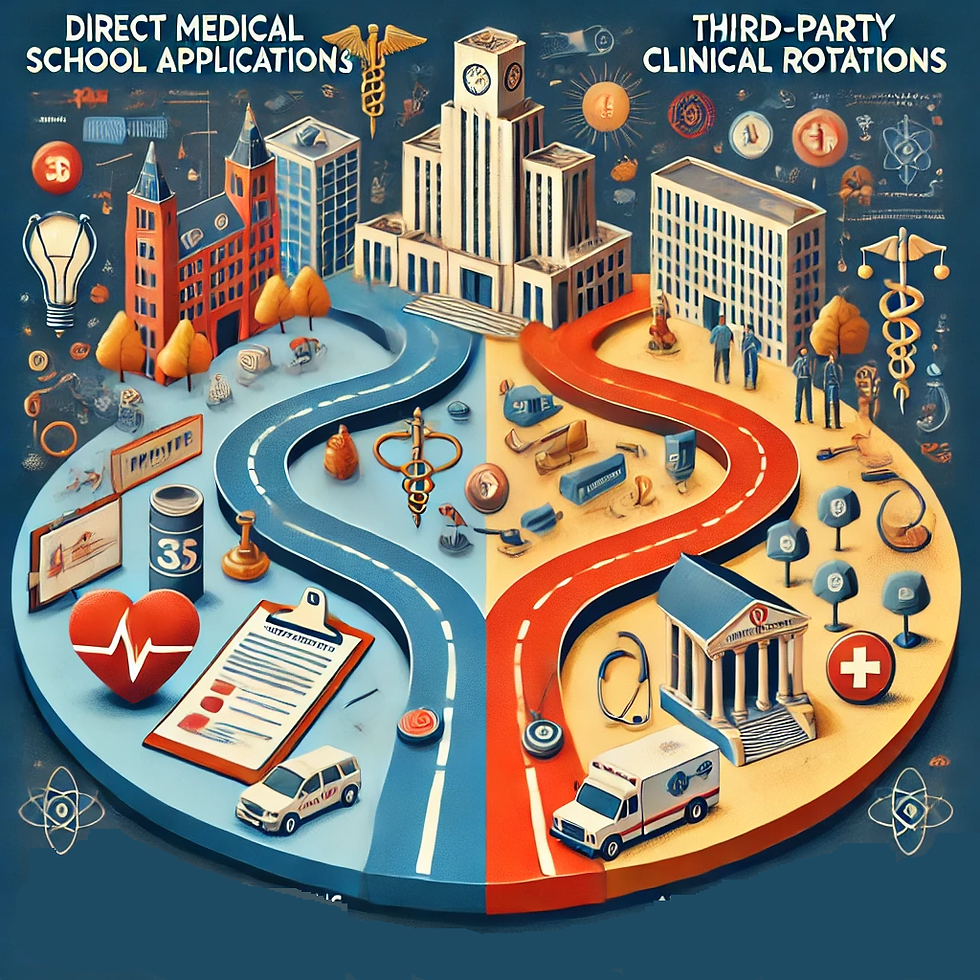How to Secure a Clinical Rotation in the US: Part 3 – Direct Applications vs. Third-Party Rotations – Which is Right for You?
- Dr. Ahmad

- Feb 24
- 4 min read
Updated: Mar 18
(Part of Our Continuously Updated Series on Securing Electives & Observerships in the US)
🚀 New to clinical rotations? Start with part 1 here: General advice
Direct Applications vs. Third-Party Rotations – Which is Right for You?

Introduction
When securing a clinical rotation in the US, there are two main options:
Applying directly to hospitals and universities
Using a third-party service like AMO Opportunities
While many assume direct applications are the cheaper and better option, the reality is more nuanced. This guide will break down costs, accessibility, competitiveness, and other key factors to help you make the best choice for your goals.
Option 1: Direct Applications to Hospitals & Universities
Many medical schools and hospitals allow students (not graduates) to apply for electives directly. However, this process is highly competitive, costly, and time-restricted.
Pros of Direct Applications
✅ Higher Prestige – Rotations at top teaching hospitals carry more weight for residency applications.
✅ Stronger Letters of Recommendation (LoRs) – Faculty at prestigious hospitals are more recognized in the residency selection process.
✅ Better Networking – Exposure to residency programs can open doors for future applications.
✅ Stronger Visa Letters – Hospitals issue stronger visa support letters compared to third-party providers.
Cons of Direct Applications
❌ Expensive – Direct applications are not free. Fees range from $200 to $6,000+ per rotation.
Example Costs (Non-Refundable Fees Apply):
Johns Hopkins: $500 registration + $5,000 elective fee + $330/month health insurance.
Stanford: $300 application fee + $125 document fee + $3,100 (2-week) or $6,200 (4-week) tuition.
Mayo Clinic: Requires USMLE Step 1 + $350 application fee + only open to final-year students.
Mount Sinai: $500 application fee + $3,150 tuition fee + USMLE Step 1 required.
Baylor: $1,000 application fee + $2,300 tuition + other minor fees.
University of Michigan: $125 application fee.
New York Presbyterian Hospital: $50 application fee + $150 per elective.
Washington University: $100 application fee (only through VSLO).
❌ Highly Competitive – Even after paying, acceptance is NOT guaranteed.
❌ Limited Specialties – Many rotations are not open to IMGs or certain specialties may not be available.
❌ Strict Eligibility – Some hospitals only accept final-year students, require USMLE Step 1, or have affiliation restrictions.
❌ Long Processing Time – Applications take months, and decisions can be uncertain.
❌ Limited Availability – Many universities only accept students during specific times of the year.
❌ Not Available for Graduates – Most direct hospital electives only accept medical students, not graduates.
➡ Best For:
Students with strong academic records and time to wait for acceptance.
Those who can afford non-refundable fees and want to aim for top-tier programs.
Applicants seeking networking opportunities and stronger LoRs.
Option 2: Third-Party Clinical Rotations (AMO Opportunities & Others)
Third-party providers offer guaranteed placements at a variety of hospitals and clinics for both students and graduates.
Pros of Third-Party Rotations
✅ Guaranteed Acceptance – No need to compete with thousands of applicants.
✅ Faster Processing – You can secure a rotation in weeks instead of months.
✅ Available for Students & Graduates – Unlike direct applications, third-party providers accept IMGs & medical graduates.
✅ Flexible Timing – Rotations are available year-round, not just during elective periods.
✅ No USMLE Requirement – Most AMO-affiliated hospitals do not require Step 1 or Step 2 CK.
✅ Refundable & Discounted Options – Some rotations offer refunds, and our Saioo + AMO partnership provides exclusive discounts.
✅ Access to a Wider Range of Specialties – More options in internal medicine, surgery, pediatrics, etc.
Cons of Third-Party Rotations:
❌ Higher Cost (but Refundable Options Exist):
Costs typically range from $1,500 – $4,000 per month.
However, some rotations are cheaper than direct hospital electives.
❌ Variable Quality:
Not all rotations are at top-tier hospitals (though some are excellent).
LoRs quality depends on the preceptor and institution.
❌ Weaker Visa Letters:
Compared to universities, some hospitals provide weaker visa support.
However, it's recognizable by US embassies.
➡ Best For:
Graduates who need US Clinical Experience (USCE).
Students and IMGs who need a rotation quickly and without the stress of competition.
Applicants who want more flexible, refund-friendly, and guaranteed placement options.
Key Comparison: Which One Should You Choose?
Factor | Direct Applications | Third-Party Rotations |
Cost | $200 – $6,000+ | $1,500 – $4,000 |
Processing Time | Several months | A few weeks |
Availability | Limited spots, strict eligibility | Open year-round, more flexible |
USMLE Required? | Often yes | Usually no |
LoR Strength | Often stronger | Depends on site/preceptor |
Visa Support | Stronger | May be weaker |
Who Can Apply? | Mostly students | Students & Graduates |
Conclusion: Making the Right Choice
🔹 If you have time, a strong profile, and want a top-tier LoR, direct applications may be worth the hassle and cost.
🔹 If you need a guaranteed rotation with fewer restrictions, faster placement, and refund flexibility, third-party providers are the way to go.
Need Help Finding a Rotation?
🔗 Explore pre-arranged clinical rotations with our trusted partner, AMO Opportunities, and use discount code SAIOO250 for $250 off! or ask us if we have more discount codes. (Now we have a $400 0ff any spot with AMO)
📌 Next in this series: Medical Schools That Accept Direct Applications for Electives
📌 Also, check out the previous blogs:
.png)



Comments